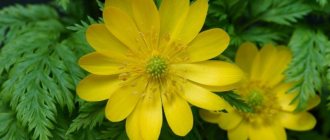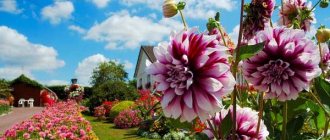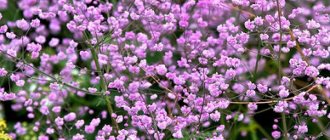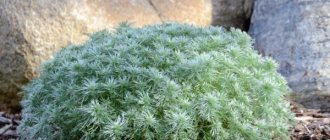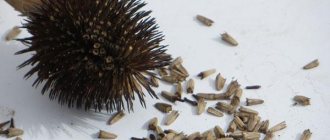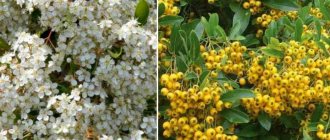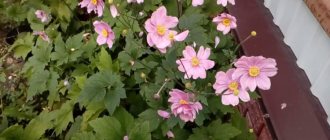Various types of ornamental shrubs are widely used in landscape design. They can serve as a hedge or be an accent in a flower arrangement. Spirea, planting and caring for it in open ground is very simple, suitable for both purposes. It is quite decorative and also unpretentious, and abundant flowering is an excellent addition to its advantages. Even a beginner can grow it.
Before you start planting this shrub, you should familiarize yourself with the rules of cultivation and further care, find out what kind of plant this spirea is.
How to grow spirea: planting and care
To grow a healthy plant that will delight you not only with lush greenery, but also with abundant flowering, you need to provide for all stages: from purchasing planting material to caring for already planted shrubs.
Spiraea - a spectacular shrub
Saplings
The first step is to purchase planting material. Depending on the purpose for which the plant will be grown, as a hedge or for single planting, it is important to decide on the variety. There are many of them, they have different requirements and external characteristics. Among this variety, there is sure to be one that is most suitable for a particular case.
Once the variety has been selected and the required number of seedlings has been determined, you can proceed directly to purchasing planting material. There are two important criteria to consider.
- The first thing you should pay attention to is the root system. It should be well developed and have at least three strong taproots. It should also be free of damage and areas with signs of disease.
- Depending on the planting period, the condition of the upper part of the plant is assessed. If the seedling was purchased in the spring, then the buds on its shoots should still be closed and not swollen. In the case of autumn planting, there should already be no leaves on the shoots.
Spiraea seedling
Planting time and technology
For planting, you can choose either autumn or summer. The main thing is to take into account the climate. The time for autumn planting should be chosen so that the plant has time to get stronger before the onset of frost, and in the spring you need to wait until the threat of frost has passed.
Planting a seedling
Important! Young seedlings are quite demanding of moisture. In case of prolonged absence of precipitation, it is necessary to regularly replenish the lack of water.
Technology
The process of planting seedlings in the ground can be divided into several successive stages.
- Digging a hole. Its diameter should exceed the size of the seedling's root system by 20-30%.
- Filling the planting hole 2/3 with prepared soil. The earth should be covered with a mound.
- Placement of seedlings. The roots of the plant need to be straightened, damaged ones removed and spread over the surface of the earthen mound.
- Filling the hole with the rest of the soil. You should ensure that the root collar of the seedling is flush with the ground surface.
- Watering. It is also advisable to mulch the soil around the plant to reduce moisture loss.
Note! Spiraea does not tolerate waterlogging of the roots. If groundwater is close to the site or the soil contains a lot of clay, a drainage layer must be made at the bottom of the planting hole. Small crushed stone, brick chips or gravel are suitable for this.
If a seedling is planted with a lump of earth, watering is done directly into the planting hole, and then it is filled with soil.
Soil preparation and site selection
Spiraea is not only unpretentious in care, but also not demanding on the soil. It can grow almost anywhere, but for a healthy plant, certain conditions must be met. It is necessary to consider what kind of soil spirea likes and where it is best to place it in the garden.
This perennial shrub does not tolerate excess moisture, and accordingly, it prefers light and well-drained soil. To improve the composition of clay soil, it is better to add sand and peat to it. If the soil is sandy and too light, it won’t hurt to add a little clay.
Also, when preparing the soil for planting, you should add compost or rotted manure to it.
Spiraea is a flowering shrub. Due to its undemanding nature, it can grow in the shade, but in this case you should not expect abundant flowering. In order for this shrub to delight not only with lush greenery, but also with flowers, it is better to choose a sunny place for planting it.
Growing in spring and autumn
Spiraea can bloom either in summer or in spring. This factor should be taken into account when choosing the time for planting. The spring period is suitable exclusively for spring-flowering varieties. In autumn, all species can be planted, regardless of their flowering period.
Important! When planting in spring, the main task is to provide young seedlings with moisture, especially in the absence of precipitation for a long time.
When planting in the fall, you need to take care of constructing a shelter for young plants for the winter. Depending on the variety, winter shelter is installed either every year or only for the first winter after planting.
Features of care in different regions
Due to its unpretentiousness and fairly high frost resistance, spirea is suitable for cultivation even in the conditions of Siberia and the Urals. Of course, not all varieties of this plant are suitable for these regions. Most suitable:
- birch leaf;
- average;
- oakleaf;
- Wanguta;
- gray;
- Billard;
- loosestrife.
Variety White Bride
Considering the difficult climatic conditions of these regions, or rather low temperatures in winter, it is necessary to shelter the spirea for the winter every year. The planting dates will also differ slightly. In the spring it is better to start this process later, and in the fall, on the contrary, earlier, before the cold weather arrives. Spirea in the Urals, the cultivation of which here is very easy, is widespread and popular.
There are no special requirements for growing this shrub in the Moscow region. When caring, you should focus on the characteristics of the variety, or more precisely on its winter hardiness. For example, the White Bride spirea, which is easy to plant and care for, can withstand frosts down to −40 °C.
Note! As a rule, all species are able to winter in the conditions of the Moscow region without shelter; this area allows them to survive the cold simply under a layer of snow. You should also consider how to properly prune your spirea to prepare for winter.
Bloom
The universal love for spirea is explained by its long and abundant flowering. Numerous small flowers are collected in pyramidal, paniculate, spike-shaped or corymbose inflorescences. Early varieties are white, summer varieties bloom with pink, lilac or crimson flowers.
The effectiveness of the bushes is explained by the duration and different periods of flowering, as well as by the way the inflorescences are located on the branches. In some species, the inflorescences completely cover the shoots, in others only the upper parts bloom, in others the ends of the branches bloom. Spring varieties of spirea bloom profusely, but not for long, and the flowering of summer species continues until mid-autumn.
Reproduction
For spirea, as for many other types of shrubs, there are several propagation options. You can get a new plant by dividing the bush, or by layering. But such an opportunity does not always present itself, especially if the owner of the shrub does not want to injure the plant in order to share it. In this case, cuttings are an excellent method of propagation.
Cuttings
Spirea Arguta - description, planting and care
There are only a few steps to take.
- Preparing the cuttings. For this purpose, you need to select a one-year-old shoot and cut it into pieces so that each has 4-5 leaves. The lower ones should be removed, the rest should be trimmed.
- Solution aging. Next, you need to place the cuttings in a solution of a growth stimulator and keep them for the required time.
- Landing in the ground. You can root cuttings either in a separate container or in open ground. The soil must be prepared in both cases.
- Installation of shelter. After planting, the cuttings should be covered with a glass jar or cut plastic bottle.
Next, you must always ensure that the soil at the site where the cuttings are planted remains moist. They will also benefit from periodic spraying.
They can be left in the ground for the winter, but be sure to cover them well. By spring, cuttings that have overwintered and become stronger can be transplanted to a permanent place.
Seeds
Another way to get a new spirea plant is propagation by seeds.
Important! This method is not suitable for all varieties. For hybrids, such as spirea Wangutta, Billard and sharp-toothed, it is not applicable.
This breeding process also consists of several stages.
- Collection of seeds. For spring-flowering species this is the beginning of June, and for summer-flowering species it is the end of this month or later.
- Soil preparation. A mixture of peat and vermiculite in a ratio of 4:1 should be poured into a special container.
- Sowing. It is produced on the surface without burying the seeds in the soil.
- Hydration. The surface of the soil should be carefully moistened with a spray bottle, being careful not to wash away the seeds.
- Shelter. The container should be covered with film or glass.
Seeds
You can place the container with seeds both indoors and outdoors. The main thing is that it is a place in partial shade and not in the sun.
As soon as the shoots appear, the film should be removed. When the sprouts reach a height of 2 cm, the seedlings need to be planted. In the fall they can be transplanted into the ground, and in the spring to a permanent place.
Problems, diseases, pests
Spireas get sick quite rarely; with timely treatment, they quickly recover and do not lose their decorative properties.
Damages leaves, young shoots and pedicels of the plant. Lives in colonies. The period of active reproduction of aphids is June-August.
Rosaceae miner
It settles in mid-summer on the surface of leaves and goes into the ground at the end of July.
Rose leaf roller
Appears at an average temperature of +13°C (late May - early June). The caterpillars roll the leaves into a tube and chew them out. If urgent measures are not taken, the pest may destroy the plant.
Spider mite
After wintering under fallen leaves, female mites move to young leaves, weave a web around the bush and lay eggs. The spider mite reproduces so actively that the entire spirea becomes covered with whitish spots, turns yellow and loses its leaves. Spider mites are especially dangerous in dry summers.
Pests can be defeated using agrotechnical, biological and chemical measures. The main weapon is spraying the bushes in dry summers, watering and fertilizing.
Granular pyrimor is suitable for controlling aphids. At the beginning of the growing season (April), a 5% solution (15 g per square meter) is added to the soil at a shallow depth (2-5 cm).
Aphids, rose leaf miners and leaf rollers do not like the effects of drugs:
- pyrimor - 0.1%;
- actellik - 0.1%;
- hostakvik - 0.1%;
- kronefos - 0.3%;
- fozalon - 0.1-0.2%;
- ethafos - 0.2%.
Spider mites will disappear after treatment with phosphamide, keltan, fozalon, metafos, karbofos or acrex. With timely initiation of treatment, when no more than three mites settle on a leaf, the result comes quickly.
Outdoor care
For full development and annual flowering, you need to know how to care for spirea and how to provide it with proper care. It consists of several important procedures.
Watering
Spirea Grefsheim - description, planting and care
This fairly drought-resistant shrub needs rare but abundant watering. 10-15 liters of water 2-3 times a month will be enough for him. If precipitation occurs regularly, this rate can be reduced. If there is a lack of moisture, shoots and leaves may dry out.
Note! Young seedlings are much more demanding of moisture. They should be watered regularly.
Also, some varieties of shrubs, such as Japanese spirea, require more frequent watering. By the way, its flowers have a pleasant pink tint.
Fertilizers and fertilizers
Spiraea is responsive to the application of fertilizers, both organic and mineral. In spring it is better to use complex mineral fertilizer. This will speed up the development and growth of the plant. Nitrogen fertilizers can be applied only during this period. In the summer, after flowering has ended, as well as after pruning, organic fertilizers are needed.
Important! Any fertilizing should be carried out only on moist soil.
To apply mineral fertilizing, it is better to choose a ready-made complex fertilizer for ornamental shrubs. It can be purchased at a specialty store. For example, the Leningrad garden center offers a large selection of similar products.
Manure or compost can be used as organic fertilizer. But this should be done with caution. Why is that? When using manure, the dosage must be strictly observed to avoid burns to the root system.
Care for spirea in spring, pruning and feeding
There are certain procedures that should be carried out in the spring. For spirea this is sanitary pruning.
Trimming
Depending on the period during which the flowering phase of the bush occurs, appropriate pruning is carried out. Spring-blooming species require minimal pruning. Only the ends of shoots that have suffered from winter cold must be removed. You should also remove all dried branches.
Shoots of late-flowering species should be trimmed significantly, leaving only 1-2 buds on them. You should also remove excess growth to avoid excessive thickening of the bush. Diseased and dry shoots should also be removed.
For your information! The spring period is excellent for applying mineral fertilizers. It is permissible to apply nitrogen-containing fertilizers only at this time.
LiveInternetLiveInternet
“Tender” on Yandex.Photos Name: received from the Greek word 'speira' - bend. The branches are very elegant and in most species they bend beautifully, which was the reason for the Latin name of the genus. But we also have our own popular name for this shrub - meadowsweet (with the emphasis in the south on the last syllable, and in the north on the first). This is completely wrong, since the genus of meadowsweet includes, although similar to spirea, only herbaceous plants, while all spirea are shrubs of varying sizes.
Spiraea 'Gold Flame' and Salvia lush Photo by Zakutnaya Natalia
From history: the plant has been known in Rus' for a long time. In the epic “Sadko,” when the hero’s ship stops in the middle of the sea, the participants in the voyage cast “Tavolzhans” lots. In this way, they identify who should be thrown into the sea as a sacrifice to the king of the sea. Considering the constancy of the text of the epics over the centuries, it can be assumed that meadowsweet (spirea) attracted the attention of our ancestors even during the period of the composition of the epic “Sadko”, i.e. before the annexation of Novgorod to the Grand Duchy of Moscow and the destruction of its liberties (1478). True, we do not know, and perhaps we will never know, why in those distant times lots were made from meadowsweet. But from V.I. Dahl’s dictionary it is easy to find out that in the steppe zone in the 19th century, meadowsweet had a completely practical and not at all decorative use. Its thin and strong rods were used for ramrods and whips. But all these ways of using spirea are in the past. Now they have value only as ornamental plants.
In the 16th century For the first time, willow spirea began to be grown (1586). After 200 years, middle and oak-leaved spireas appeared in cultivation. At the end of the 19th century. Birch leaf spirea was introduced into the culture. Now the northernmost point of cultivation of these species is the city of Kirovsk on the Kola Peninsula, where they are in the collection of the Polar-Alpine Botanical Garden. Some spirea are used in gardening and landscaping quite often, others - only sporadically. But almost all species, due to their decorativeness, duration of flowering, frost resistance, gas resistance and ease of propagation, deserve more attention from gardeners. Spiraea beauverdiana Photo by Kirill Kravchenko Spiraea hypericifolia Photo by Kirill Kravchenko Spiraea Wangutta 'Aurea' Photo by Marina Prikhodko Description: the genus includes about 90 species, distributed mainly in the forest-steppe, steppe and semi-desert zones, the subalpine zone of the mountains of the Northern Hemisphere. Deciduous shrubs, rarely exceeding 2 m in height. The natural shape of the bush is very different, there are: pyramidal, weeping, hemispherical, erect, creeping, cascading, etc. Species differ among themselves in the shape and color of graceful leaves; many change their green attire to orange, yellow or purple-red in the fall. A large number of diverse species allows, with skillful selection, to achieve continuous flowering from spring to late autumn. Spiraea are valued for their abundant and long-lasting flowering. Their flowers are small but numerous, collected in inflorescences of various shapes: corymbose, paniculate, spike-shaped or pyramidal. Some have single flowers. The color of the flowers is also varied - from pure white to crimson. The decorative effect of spirea is determined not only by the different arrangement of inflorescences on the shoots, but also by the timing of flowering. Thus, there are species whose inflorescences completely cover the entire shoot (sharply serrated spirea); in others, the inflorescences are located only on the upper part of the shoots (medium spirea; Bumalda spirea); in others - at the ends of the shoots (willow spirea; Japanese spirea). Based on the time of flowering, they are divided into two groups - spring-blooming and summer-blooming. In the former, flowering usually occurs on last year's shoots and the flowers are white; representatives of the second group have pink, red, crimson flowers, and flowering occurs on the shoots of the current year. This division is also reflected in the agricultural technology of caring for spirea; Species that bloom in spring are pruned immediately after flowering, and those that bloom in the second half of summer are pruned only in spring. Plants of the first group bloom together, but not for long; in the second group, flowering is more extended. All spirea are undemanding to the soil, light-loving, frost-resistant, many types are smoke and gas resistant, and tolerate city conditions well. They are easily propagated by dividing the bush, cuttings, layering, shoots and seeds. They grow quickly and bloom in the third year. A group of spring bloomers. This group includes species in which flower buds are formed on the shoots of the previous year. Flowering of these species begins in the second year of shoot life. They are characterized by the formation of numerous tillering shoots. For example, a 10-year-old plant has from 30 to 60 of them. Pruning this type of spirea comes down to completely removing (after 7-14 years) outdated shoots and annually removing the tips of frozen ones. Species: Alpine spirea - Spiraea alpina Spiraea Vanhoutte - S. x vanhouttei (Briot) Zab. Crenate spirea - S. crenata L. Oak-leaved spirea - S. chamaediyfolia L. St. John's wort spirea - Spiraea hypericifolia Cantonian spirea - S. cantoniensis Lour. Spiraea multiflora - S. x multiflora Zab. Nippon spirea - S. nipponica Maxim. Sharp-toothed spirea, or arguta - S. x arguta Zab. Lovely spirea - S. bella Sims. Gray spirea - Spiraea x cinerea Plum-leaved spirea - S. prunifolia Sieb. et Zucc. Middle spirea - S. media Fr.Schmidt Thunberg's spirea - S. thunbergii Sieb Three-lobed spirea - S. trilobata L. Emilia's spirea - Spiraea aemiliana The flowers of spring-blooming spireas are white and collected in umbrella-shaped inflorescences formed in the axils of the leaves on last year's shoots. In May, the entire spirea bush is covered with a snow-white cloud of many inflorescences, under the weight of which the branches take on a spectacular drooping shape. Spiraea Thunberg Spiraea oakleaf has a slightly weeping bush shape, reaches 2 meters in size, begins to bloom earlier than other species - in the second half of May. At this time, the bush is covered from top to bottom with large white inflorescences. Like all spring-flowering species of ornamental shrubs. oakleaf requires summer pruning after flowering. This plant prefers fertile soil and a sunny location, and is a highly winter-hardy species. Due to its tendency to “spread” with the help of root shoots, it is often used to decorate public city parks. Spiraea Arguta, or sharp-toothed, also belongs to the group of spring-flowering spirea and is a bush 1.5-2 m high with drooping branches with bright green narrow leaves. It blooms profusely and for a long time, starting from the end of May. Gray or ashy spirea is very similar to the previous species, differing only in the color and texture of the leaves - they are pubescent, gray-green in color. The most famous variety is "Grefsheim". Spiraea gray Grefsheim Spiraea x cinerea Grefsheim The best spring flowering spirea. Snow-white double flowers completely cover the shoots. Exceptionally abundant and early flowering. Spiraea gray Grefsheim is a beautifully flowering deciduous shrub with numerous picturesque drooping arched branches. The height and diameter of the spirea bush is up to 1.5 - 2 meters. Unpretentious, characterized by unusually abundant annual flowering. The crown is spreading, wide-rounded. It blooms in May-June, flowers up to 1 cm, snow-white, double, collected in umbrella inflorescences that densely cover the entire bush, flowering duration is about 45 days. Spiraea gray "Grefsheim" is an excellent honey plant, flowering from the second year. Grows quickly. Good haircut. Light-loving, but also tolerates partial shade. Sensitive to drought and elevated air temperatures. It is completely winter-hardy in the conditions of the North-West, but in severe winters young shoots sometimes freeze. Spiraea gray Grefsheim is undemanding to soil, grows on all cultivated garden soils, from acidic to slightly alkaline, prefers evenly fresh substrates. Read in full here: https://www.rosselhozpitomnik.ru/prodaga/listvennye/spirei/spireya_seraya_grefshejm/ Nipponian spirea is a low shrub about a meter high with a dense spherical shape that can be formed into a creeping one. It blooms in late May - early June with white flowers in small inflorescences, abundantly covering the bush from top to bottom. Nipponian spirea is not too demanding on soil fertility, can grow in light shade, is not afraid of frost or drought, but can freeze in severe winters. Ideal for central Russia. Spiraea Van Gutta is a tall shrub up to 2.5 m high with long curving branches with bluish-green leaves, blooms in the second ten days of June, grows quickly, and is photophilous. Cantonese spirea - S. cantoniensis Lour. Naturally distributed in China and Japan. A low shrub, up to 1.5 m tall, with thin, arching branches. The leaves are rhombic or oblong, toothed-notched, not exceeding 5.5 cm in length, crenate or with three lobes; dark green above, bluish below. Flowers are up to 1 cm in diameter, white, in dense, umbellate inflorescences. This spirea blooms in late June - early July for 25 days on the shoots of the previous year. It grows very quickly, tolerates drought well, and is thermophilic. In the middle zone, the shoots of this spirea are often damaged by frost; it is important for it to find the most protected, warm place or to provide light shelter and appropriate agricultural technology. A very decorative spirea, especially its lanceolate form. Of all those used in our gardening construction, it is of greatest importance in landscaping in the extreme south of Russia. In addition to being used in single, group and border plantings, it provides excellent cutting material. Group of summer bloomers. In plants of this group, the inflorescences are completed by young shoots of the current year. The next year, inflorescences appear again at the ends of the lateral young shoots, and the tops of the old ones dry out. After the third year of life, old shoots are rejuvenated by removing the upper part. If aging shoots are not removed, the top of the old shoot deviates strongly towards the ground and gradually dries out. The entire shoot lives for 6-7 years, but since the plant produces abundant root shoots and shoots from the root collar, the entire plant as a whole is durable. After the fourth year of the crop, it is recommended to trim the entire upper part of the bush annually in the spring at a height of 25-30 cm from the ground. Summer-flowering spireas are characterized by pink coloring of flowers, which are collected in corymbose or pyramidal inflorescences formed at the tops of young growing shoots. Flowering, depending on the variety and type, begins in June-July and continues until cold weather. Species: White spirea - S. alba White-flowered spirea - S. albiflora (Miq.) Zbl. Birch-leaved spirea - Spiraea betulifolia Life form: deciduous shrub up to 1.0 m high with a compact crown, quite dense and wide with ribbed, sometimes zigzag-curved shoots. Leaves: intense green, birch-like with a wedge-shaped base. In autumn it turns bright yellow. On acidic soils, autumn colors are brighter - red-orange, crimson and even purple. Blooms: in June. The white-cream flowers are collected in wide convex shields. Growing characteristics: light-loving, tolerates partial shade. Drought resistant. It is undemanding to soil fertility, can grow on rocky soils, but blooms better on loamy, moist soils. Use: recommended for purebred and mixed groups, trimming tall bushes. Billard's spirea - S. x billardii Bumalda's spirea - S. x bumalda Burv. Tomentose spirea - Spiraea tomentosa Dense-flowered spirea - Spiraea densiflora Douglas spirea - S. douglasii Hook. Willow spirea - S. salicifoiia L. Dwarf spirea - S. x pumilionum = S. lanciflora x S. decumbens Low spirea - S. humilis Lilac spirea - S. x syringaeflora Lem. Broadleaf spirea - Spiraea latifolia Japanese spirea - S. japonica L. Japanese spirea is represented on the flowering shrub market in many varieties and varieties. Some varieties, such as "Nana" (pink flowers), "Little Princess" (white-pink flowers with a deep pink center), "Golden Princess" (pink flowers against a background of bright yellow foliage), "Darts Red" (in buds - pink, when blooming - purple), "Shirobana" (in the corymbs there are both white and bright pink flowers) in size do not exceed 0.5-0.6 m and are ideal for alpine slides and as padding for taller neighbors. Here you can add white-flowered spirea, its height is also about 60 cm, and the flowers are white, which is unusual for summer-blooming spirea, and very fragrant. The “Macrophylla” variety, up to 1.3 m high, is interesting for the color of its leaves - purple-red when blooming, gradually becoming green, because of this the bush has a decorative appearance all season, in the fall the leaves are yellow. When growing spirea, it is recommended to follow basic agrotechnical rules. Use: spirea are decorative and differ in the shape and color of the foliage, the size and shape of the bush, the shape and color of the inflorescences. In addition, they bloom at different times, so a beautiful garden decoration can be created only from shrubs of this genus, knowing and skillfully selecting species based on these characteristics. Thanks to such knowledge, you can create a garden of continuous flowering, in which from May to September beautifully flowering bushes will be fragrant, the spring white color of which will be replaced by pink and crimson. Flowering begins with Spiraea sharp-toothed, gray and medium in May and ends with Spiraea tomentosa, which blooms until September. Due to the different shapes and sizes of shrubs, they can be used in various types of plantings. Thus, in single plantings, sharp-toothed spirea, Vangutta, medium, gray, white, and Douglas are indispensable. These are tall spirea, often with a very beautiful bush shape due to arched shoots. Almost all types of spirea can be used in groups. In such cases, several specimens of the same species or variety are planted nearby. Many not very tall spirea are used for edge planting around trees or taller bushes. Various red-leaved or golden varieties of spirea look especially beautiful, framing ordinary green-leaved groups of trees and shrubs. For low borders, species such as birch-leaved, low, Bumalda, Japanese, white-flowered, and dwarf spirea are suitable. These same species can be used to create rockeries and planted on a hill. Dwarf spirea is also used as a ground cover plant. Thanks to the abundant formation of root shoots, it forms picturesque clumps. In hedges that are taller than borders, taller species can be used: white spirea, Douglas spirea, willow spirea, Billiarda. All spirea are good honey plants. Therefore, in areas where different types of spirea are collected, hives can be kept. All types of spirea can be used for cutting into bouquets or arranging bouquets of other flowers. Spiraea has high phytoncidal activity, which increases its sanitary and hygienic role in improving the environment. Read more about this and watch: Spiraea - landscaping favorites https://www.drugsbrand.info/tselebne/spirei-favority-ozeleneniya/ Types and varieties of spirea (photo): https://lizgard.com.ua/rasteniya/listvennye -kustarniki/spireya.html Sources used: https://flower.onego.ru/kustar/spiraea.html https://sazhaemsad.ru/spireya-carica-sadov.html https://www.ksist.ru/index .php?do=static&page=%…0%FF%20(Spiraea%20betulifolia)
Spiraea hedge
Garden hydrangea - planting and care in open ground for beginners
This shrub is excellent for use as a hedge. This green wall will not require much maintenance. Such a quality as rapid growth will allow you to get a thick green hedge in a short time. For example, gray spirea, the pruning and formation of which is quite simple, is ideal for such purposes. During the flowering period, she looks like a real princess in white.
Living white hedge
Many varieties are suitable for use as hedges, and some of them do not even require pruning. But to get the desired shape, you should know how to trim the spirea.
Caring for such a hedge is identical to that used for this shrub when planted alone. But there are points that should be taken into account in this case.
- It is better to decide immediately on the amount of planting material needed and purchase seedlings in one store. This will eliminate the possibility of planting different varieties.
- When planting, you should take into account the characteristics of the shrub variety. Depending on the size of an adult plant of a given species, the distance between seedlings in a row should be determined.
Important! Planting spirea for hedges is carried out using the trench method. The planting technology is identical to the method used in single plantings.
Spirea transplant
Not all shrubs can tolerate transplanting to another place, since this is quite stressful for the plant. However, spirea is not one of them.
Is it possible to replant spirea?
This ornamental shrub can be replanted at any age. This can be done either as a separate operation or by combining this event with one of the vegetative propagation methods - dividing the bush.
When to replant spirea
Adult bushes are replanted in the fall. The best time to do this is when the leaves begin to change color before leaf fall. To carry out the transplant, choose a cloudy rainy day.
Transplanting an adult spirea
Before transplanting spirea, it is necessary to carry out sanitary pruning of the bush, cutting out all dry branches, as well as cutting off all skeletal shoots to the bud. If the bush is replanted as a whole, it is dug out along with a lump of earth on the roots, transferred to a new place, planted in a planting hole, and then watered abundantly.
Care for spirea after flowering
Regardless of the period during which spirea blooms, it is better to remove faded brushes. For early flowering varieties this procedure is mandatory. This should be done immediately after flowering.
For varieties that bloom in summer, removing dried flowers is also desirable, but this can also be done with autumn pruning.
Early flowering varieties undergo gentle pruning in the spring and light shaping throughout the season. Late-flowering ones should be pruned more carefully, and shoots should be significantly shortened in early spring.
Dried and damaged shoots should be removed during spring and autumn pruning. This applies to all types of this shrub.
Important! Pruning should be carried out in such a way that the bush consists of shoots of different ages. This will ensure his proper development. You should also adhere to deadlines, taking into account when it is necessary to cut the spirea.
Preparing for winter
Before the plant enters a dormant period for the winter, it should be subjected to sanitary pruning. All dry shoots must be removed. The shoots are shortened to a length that is applicable specifically to this species. Autumn pruning should be carried out in such a way that the plant has time to move away from it before the onset of cold weather.
How to feed spirea during this period? After this procedure, you can feed the bush with complex potassium-phosphorus fertilizer.
Some types of spirea require shelter for the winter, and certain varieties can overwinter under snow. It is the requirements of the variety that you should focus on when deciding to install a shelter.
Spirea pruning
Now let's talk about pruning, which differs for summer-flowering and spring-flowering spirea, since the inflorescences of these groups are formed on shoots of different years.
Pruning spring-flowering spirea
- In spireas that bloom in May-early June, flower buds are evenly laid along the entire length of the shoots, but they bloom only the next year. Therefore, pruning such spireas comes down to shortening frozen and dried shoots. It is usually carried out annually in early spring (March to April).
- Mature old branches and thin shoots are removed once every two years in the spring.
- Also, such bushes undergo anti-aging pruning. To do this, old branches (over 7 years old) are cut out completely.
Pruning summer-blooming spireas
In plants that bloom in July–August, inflorescences form at the ends of the shoots of that year. The next year, these inflorescences dry out, and new flowers form again on the young shoots.
- Shrubs of this group are pruned in early spring, at the very beginning of the appearance of leaves. Each well-developed branch is shortened to powerful buds, and small and too thin shoots are cut out completely.
- After the fourth year of cultivation, it is advisable to prune the bushes at a height of 25-30 cm.
| Summer-blooming spireas are short-lived. Bushes should be replaced at the age of 15-20 years. When replacing plants, they usually focus on the quality of flowering and growth of shoots. If they have noticeably decreased and anti-aging pruning (to the stump) does not help, then the shrub needs to be replaced with a young one. |
Diseases and pests
Spiraea is very resistant to diseases and pests. But still, sometimes it can be susceptible to various types of fungi and the attack of certain pests. For example, such as:
- aphid;
- spider mite;
- leaf roller;
- whitefly
In such cases, significant damage can be caused to the plant. To avoid this, you should regularly treat the bush with special preparations for preventive purposes.
Spiraea is an ornamental shrub that is unpretentious and frost-resistant. There are many varieties of this shrub, which differ not only in external characteristics, but also in the methods of caring for them.
Important! For full growth and flowering, this shrub should be provided with well-drained soil, moderate watering and regular fertilizing. Proper annual pruning is also necessary.
Spiraea can be propagated by dividing the bush, layering, cuttings and seeds. The cutting procedure is easy to carry out, and the survival rate of the resulting seedlings is quite high. To combat pests and diseases, regular preventative treatment with chemicals is necessary. Only if suitable conditions are provided will spirea delight you with lush foliage and abundant flowering all year round.
Directory of indoor plants
Spiraea (meadowsweet) is a shrubby deciduous plant from the Rosaceae family.
Belongs to ornamental plants, used to decorate landscape compositions. The plant is very popular. It is best to use spirea for group planting. Often, hedges are created with the help of this shrub. There are also dwarf varieties of spirea that look great as an element of a stone garden, creating carpets along with other low-growing plants and for rockeries. However, the spirea bush can also become a central composition, separately planted in the garden.
The spirea bush attracts attention in mid-summer, when most varieties have already bloomed. Growing a plant is convenient for both novice gardeners and experienced gardeners who just want to enjoy the process, relax and enjoy the flowering.
Features of care: spirea flowering
Most varieties of spirea are summer-flowering plants. In general, spirea is an unpretentious plant to care for. One of the basic methods of caring for shrubs is pruning every year.
How to prune spirea for flowering?
Spirea pruning is carried out in the spring (early period). In order to stimulate the beginning of flowering, it is necessary to shorten the shoot to large buds. Small and weak shoots are removed from the spirea bush, as well as those strong ones that did not bloom last year. After 4 years on the site, the spirea bush is cut to 30 cm.
Why doesn't spirea bloom?
Summer-flowering spirea shrubs do not bloom at the same time, so if the expected, lush decoration does not appear on the site, you may need to wait a little.
Why does spirea not bloom:
- Clogged soil mixture;
- Lack of watering;
- Temperature changes;
- Not pruned;
Spiraea is an unpretentious plant that is resistant to diseases and weather changes, however, even such a tin soldier may have problems.
First of all, it is worth considering the conditions necessary for development: air temperature, sufficient lighting. Despite the fact that spirea can withstand any cold and temperature changes, there is no eternal life under the sun - the shrub can also suffer from violations of basic care.
Watering spirea is a regular activity. It is recommended to water the spirea not too often, but an overdried soil mixture is clearly detrimental to the shrub.
By clogged soil mixture we mean planting the plant not in soil that is neutral and loose in consistency, but in a heavy soil mixture with a shifted acid-base balance to either side. There is also no need to feed spirea with fertilizers that it cannot “digest.”
Pruning is the main source of spirea flowering. Spring pruning is carried out annually. For spring-blooming spireas, dooming should be done as early as possible.
The problem with flowering mainly occurs with spring spireas, since they are weaker and more frail than summer varieties of shrubs. Planting this type of spirea requires additional care and protection from the negative effects of unsuitable weather conditions, and one hundred percent care in compliance with basic rules.
Please rate the material you read :)
Spirea got its name from the Greek “speira” - spiral. The branches of most types of ornamental shrubs bend gracefully, forming thick fluffy caps of flowers. In our country, spirea is mistakenly called meadowsweet because of its external resemblance to this herbaceous plant.
The deciduous spirea shrub usually does not exceed two meters in height. The shape of the bush, color and type of inflorescences depend on the variety. There are spring-flowering and summer-flowering bushes. Early species bloom more profusely, but bushes that bloom by mid-summer adorn front gardens, parks, squares and garden plots for a long time. Even after the flower petals fly off, spirea delights with the bright colors of autumn leaves, turning orange, bright red or yellow.
Spiraea flowering
Depending on the type of plant, flowering occurs in different parts of the shoot. Flowers can cover all branches, their upper part, or only their tips. Flowers are usually collected in inflorescences, which can be of the following forms:
- shield;
- paniculata;
- spicate;
- pyramidal.
The color range of inflorescences is very wide. Flowers can be snow-white, cream, crimson, pink.
When does spirea bloom?
According to the type of flowering, all types of this shrub are divided into spring-flowering and summer-flowering. They differ in that in the first, flowering occurs on the shoots of the second year of life, and in the second, in the first. Spring-flowering spireas bloom quite early. Most of these species bloom at the end of May. Summer-flowering species begin to bloom in July-August.
How long does spirea bloom?
The flowering of spring-flowering spireas is usually friendly and not extended over time. It lasts about 3 weeks. The flowering of summer-flowering species is longer, lasting 6-8 weeks.
Reasons why spirea does not bloom
One of the reasons for the lack of flowers may be that the bush is too young. This plant usually blooms at 4, sometimes at 3 years of age. Often the first flowering may be limited to the appearance of just a few unopened buds. Another reason may be lack of sunlight. In closed areas, in shade or even partial shade, the bush may not bloom at all.
Lack of watering can also affect flowering if the weather is too dry. A shift in the acid balance of the soil in one direction or another also negatively affects the development of shrubs. When planting a certain variety of spirea, you must take into account the characteristics of the soil. For example, Wangutta spirea thrives in alkaline soils, while Douglas spirea prefers soils with high acidity.
Proper care is the key to beauty and abundant flowering
Spirea is quite undemanding in care. For good lush flowering and normal growth, the shrub needs a lot of sunlight, fertile soil and watering. Sheltering spirea for the winter is not always required, only in northern regions with a harsh cold climate and for young plants planted in the fall.
Spiraea planted in spring should be well watered, especially in the southern regions, in the Kuban, where spring and summer can be quite hot. In summer, pay special attention to watering; make sure that the soil in the tree trunk circle does not turn into an earthen crust; this is important for recently planted spirea plants.
The tree trunk space can be mulched with peat to create an optimal microclimate and retain moisture. Instead of peat, you can use humus, which will retain moisture and be a good fertilizer that nourishes the spirea.
Spirea needs to be fertilized only when necessary; the shrub grows well without fertilizing. Typically, food is given in early spring using mineral fertilizer containing nitrogen. In the fall, only phosphorus-potassium fertilizers are applied so that the plant gains strength for wintering. Nitrogen fertilizers and mullein should not be applied starting from August, so as not to cause the growth of young shoots. When caring for spirea, many gardeners prune not only to give it an aesthetic appearance, but also for the purpose of sanitation, removing weakened, dry, broken branches. Although the plant is rarely affected by pests or more, sanitary measures once a year are necessary. Spirea pruning is carried out in autumn or spring. It is advisable to trim mature powerful bushes in the autumn so that the flowering in the spring is more abundant. Young seedlings, as a rule, do not need to be pruned in winter; it is better to do this in the spring, when it is clear that the plant has overwintered (frozen shoots are removed).
Reproduction of spirea is quite easy; it can be propagated by cuttings, layering or seeds (with the exception of hybrid varieties). If you decide to grow spirea from seeds, then take regular varieties (not hybrids). You will need a container, box, or other container in which the peat is placed and well moistened. The seeds are sown, covered with film, and planted in a warm place. When the seedlings grow a little, pick them. Plant in open ground when the threat of frost has passed, mulch and monitor watering. Spiraea grown from seeds will begin to bloom no earlier than after 2-3 years.
Spiraea can be propagated by cuttings that are green or lignified. Cuttings are carried out in June. Take a good pruning shears with a sharp blade and cut off the young shoots at the base (in the root zone). You can leave the leaves and scratch the bark with pruning shears, so the formation of roots will begin faster. The cuttings are buried in the ground until the leaves begin to grow, and be sure to water them.
Reproduction by layering is carried out in the spring with the appearance of the first leaves. A healthy young and flexible shoot you like is bent to the ground, secured with iron brackets and covered with earth, and watered regularly. Dividing the spirea bush should be done with a sharp shovel in early spring, carefully cutting off the necessary part, which then needs to be transplanted to a new place.

